Top NBA Prospects in the Pac-12, Part One
(#1) Jaylen Brown (Scouting Video)
Top NBA Prospects in the Pac-12, Part Two
(#2) Jakob Poeltl (Scouting Video)
Top NBA Prospects in the Pac-12, Part Three
(#3) Ivan Rabb (Scouting Video)
Top NBA Prospects in the Pac-12, Part Four
(#4) Tyrone Wallace (Scouting Video)
Top NBA Prospects in the Pac-12, Part Five
#5: Allonzo Trier
#6: Gary Payton II
#7: Jabari Bird
#8: Tyler Dorsey
#9: Dillon Brooks
#10: Dusan Ristic
[url=Top NBA Prospects in the Pac-12, Part Six
#11: Thomas Welsh
#12: Kaleb Tarczewski
#13: Brekkott Chapman
#14: Reid Travis
#15: Josh Scott
#16: Rosco Allen
#17, Mark Tollefsen, 6-9, Senior, SF/PF, Arizona
Jonathan Givony
A starter the last two seasons at San Francisco, and named a second team All-WCC player as a junior, Mark Tollefsen elected to transfer to Arizona this past spring. He will become immediately eligible as a graduate-transfer after redshirting his freshman season, finishing his fifth year of college basketball at one of the top programs in the country, giving him a tremendous platform to showcase himself.

Tollefsen was a highly efficient and versatile option for the Dons the past three years, posting a career 64% true shooting percentage and making 38% of his nearly 4.5 3-point attempts per game. While he does not possess a great frame, something he's undoubtedly been working on with Arizona's strength and conditioning coaches, he's a solid athlete who moves very well at 6-9 and can elevate impressively around the basket both in transition and in the half-court.
Tollefsen's calling card as a pro prospect likely revolves around his outside shooting. He made over 100 3-pointers in his three seasons at USF, and was a very reliable floor spacing option from the power forward position with his feet set. The lefty has somewhat of an unorthodox stroke, shooting a two-handed shot with a bit of a deliberate wind-up and a slight lean back. He shoots it the same way every time and sees very consistent results, but his slow and fairly low release point makes it difficult for him to get it off when tightly contested and prevents him from being much of an off the dribble threat.
Tollefsen was more than just a shooter for USF, as he made three times as many 2-pointers as 3s and did so with spectacular efficiency, hitting 61% of his attempts (65% for his career). While he isn't much of a threat to create his own shot from the perimeter, he can attack a closeout nicely, moves very intelligently off the ball, and can even find some success operating with his back to the basket, even if his lack of strength will likely hamper him from doing so against elite-level competition. He prefers to shoot with his natural left hand, but can also make shots with his right hand around the rim as well, showing excellent touch on his floaters and utilizing the glass frequently.
Despite playing on a team that finished just 7-11 in the WCC, and did not have a great deal of talent surrounding him, Tollefsen played in a very unselfish manner that bodes well for his transition to being a role-player at Arizona and beyond. Posting a positive assist to turnover, and showing a high basketball IQ as indicated by his excellent shooting percentages, Tollefsen frequently made the extra pass along the perimeter or inside the post.
Defensively, Tollefsen's lack of strength could get taken advantage of at times guarding the post, but he showed some potential stepping out to the perimeter and moving his feet to stay in front of smaller players. He'll get knocked off balance at times, and can get backed down inside the paint, but puts a solid effort in overall. Tollefsen's body type indicates he's likely best suited guarding small forwards or face-up power forwards, something he'll likely be asked to do quite a bit of at Arizona this upcoming season, so it will be interesting to see how he fares in that role.
6-8+ combo forwards who can stretch the defense are all the rage in professional basketball these days, and Tollefsen shows some intriguing attributes that could help him get noticed quickly as a role-player for Arizona this season. Turning 23 in November, he'll be quite a bit older than most of the players draft this upcoming June, so it will be interesting to see what he can do to alleviate concerns about his frame until then.
A starter the last two seasons at San Francisco, and named a second team All-WCC player as a junior, Mark Tollefsen elected to transfer to Arizona this past spring. He will become immediately eligible as a graduate-transfer after redshirting his freshman season, finishing his fifth year of college basketball at one of the top programs in the country, giving him a tremendous platform to showcase himself.

Tollefsen was a highly efficient and versatile option for the Dons the past three years, posting a career 64% true shooting percentage and making 38% of his nearly 4.5 3-point attempts per game. While he does not possess a great frame, something he's undoubtedly been working on with Arizona's strength and conditioning coaches, he's a solid athlete who moves very well at 6-9 and can elevate impressively around the basket both in transition and in the half-court.
Tollefsen's calling card as a pro prospect likely revolves around his outside shooting. He made over 100 3-pointers in his three seasons at USF, and was a very reliable floor spacing option from the power forward position with his feet set. The lefty has somewhat of an unorthodox stroke, shooting a two-handed shot with a bit of a deliberate wind-up and a slight lean back. He shoots it the same way every time and sees very consistent results, but his slow and fairly low release point makes it difficult for him to get it off when tightly contested and prevents him from being much of an off the dribble threat.
Tollefsen was more than just a shooter for USF, as he made three times as many 2-pointers as 3s and did so with spectacular efficiency, hitting 61% of his attempts (65% for his career). While he isn't much of a threat to create his own shot from the perimeter, he can attack a closeout nicely, moves very intelligently off the ball, and can even find some success operating with his back to the basket, even if his lack of strength will likely hamper him from doing so against elite-level competition. He prefers to shoot with his natural left hand, but can also make shots with his right hand around the rim as well, showing excellent touch on his floaters and utilizing the glass frequently.
Despite playing on a team that finished just 7-11 in the WCC, and did not have a great deal of talent surrounding him, Tollefsen played in a very unselfish manner that bodes well for his transition to being a role-player at Arizona and beyond. Posting a positive assist to turnover, and showing a high basketball IQ as indicated by his excellent shooting percentages, Tollefsen frequently made the extra pass along the perimeter or inside the post.
Defensively, Tollefsen's lack of strength could get taken advantage of at times guarding the post, but he showed some potential stepping out to the perimeter and moving his feet to stay in front of smaller players. He'll get knocked off balance at times, and can get backed down inside the paint, but puts a solid effort in overall. Tollefsen's body type indicates he's likely best suited guarding small forwards or face-up power forwards, something he'll likely be asked to do quite a bit of at Arizona this upcoming season, so it will be interesting to see how he fares in that role.
6-8+ combo forwards who can stretch the defense are all the rage in professional basketball these days, and Tollefsen shows some intriguing attributes that could help him get noticed quickly as a role-player for Arizona this season. Turning 23 in November, he'll be quite a bit older than most of the players draft this upcoming June, so it will be interesting to see what he can do to alleviate concerns about his frame until then.
#18, Elijah Stewart, 6'5, Sophomore, Shooting Guard, USC
Derek Bodner
6'5 wing Elijah Stewart came on strong towards the end of the season, starting the last 8 games for USC while averaging 13 points, 4.4 rebounds, 1.75 blocks and 1.5 steals in just over 30 minutes per game over that span, connecting on 43.4% of his three point attempts. Stewart's emergence down the stretch was a ray of light in an otherwise disappointing season for the Trojans.
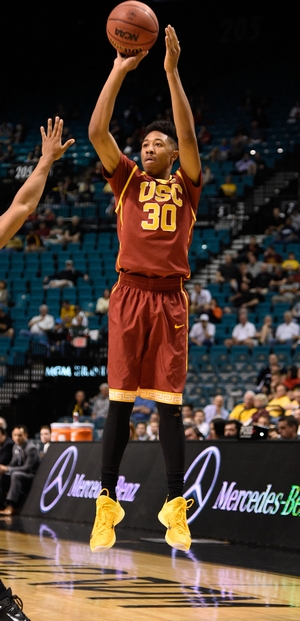
On the offensive side of the court, over half of Stewart's field goal attempts came from behind the three point line, where he connected at a respectable 34.6% clip. Stewart gets excellent elevation on his jump shot and can get the shot off with relatively little space, doing a good job getting in position before the pass, providing him with a relatively quick release. His form can break down occasionally, with his shooting elbow flailing out at times, but Stewart shows a natural shooting touch, and it's something that he should be able to correct with repetition.
Stewart also shows an ability to shoot off the dribble as well as from the catch, with comfort taking one or two dribbles in either direction to setup a step-back jump shot. Because of his athleticism, Stewart is able to rise up over his defender to get separation, giving him a clean look at the basket. Stewart's overall effectiveness when shooting off the dribble, only 0.719 points per possession according to Synergy Sports Technology, still leaves something to be desired, but shot selection likely has a significant impact on that number, and it's something that he could see an improvement in down the line.
The rest of Stewart's half-court offense mostly comes off the ball. While he's an incredible athlete, with great ability to elevate in the lane and a quick first step, his ability to create off the dribble is largely held back by his mediocre ball handling ability, especially with his left hand. Rarely does Stewart get all the way to the rim off the dribble, instead settling for difficult, contested perimeter jump shots, when asked to create for himself.
On the positive side, Stewart does find ways to contribute without the ball in his hands. Besides shooting off the catch, which does have the potential to be a strength of his down the line, Stewart's athleticism makes him a threat both cutting to the basket and off offensive rebounds, with Stewart finishing a number of emphatic putback dunks that showcased his athleticism for the position.
On the defensive side of the court is where Stewart most consistently made an impact for the Trojans last season. Stewart has good length for his position and moves his feet very well on the perimeter, which, combined with his high activity level, can cause some problems for opposing offenses, as Stewart averaged 1.6 steals per 40 minutes pace adjusted. Stewart also averaged an impressive 1.9 blocks per 40 minutes pace adjusted, which is the top figure for a shooting guard in our top-100, and shows how quickly Stewart can get off his feet, either off of one or two feet, another one of his athletic gifts.
Beyond just the numbers, Stewart was largely an attentive defender. While he could get caught ball watching and gambling for steals when playing off the ball, Stewart largely did a good job keeping himself close enough to his man that he could recover while still keeping himself in proper closeout position. Stewart is largely an engaged defender who gives consistent effort, and this should form the basis of his standing as a prospect down the line.
Stewart is far from a polished prospect, especially offensively, where a little more consistency on his jump shot and more confidence in his ball handling ability would go a long way to helping him find a role at the next level. That being said, there are signs that point to potential as a 3-and-D type of player down the line, and having the athleticism, and mindset that Stewart has is a good starting point for him to build on.
6'5 wing Elijah Stewart came on strong towards the end of the season, starting the last 8 games for USC while averaging 13 points, 4.4 rebounds, 1.75 blocks and 1.5 steals in just over 30 minutes per game over that span, connecting on 43.4% of his three point attempts. Stewart's emergence down the stretch was a ray of light in an otherwise disappointing season for the Trojans.

On the offensive side of the court, over half of Stewart's field goal attempts came from behind the three point line, where he connected at a respectable 34.6% clip. Stewart gets excellent elevation on his jump shot and can get the shot off with relatively little space, doing a good job getting in position before the pass, providing him with a relatively quick release. His form can break down occasionally, with his shooting elbow flailing out at times, but Stewart shows a natural shooting touch, and it's something that he should be able to correct with repetition.
Stewart also shows an ability to shoot off the dribble as well as from the catch, with comfort taking one or two dribbles in either direction to setup a step-back jump shot. Because of his athleticism, Stewart is able to rise up over his defender to get separation, giving him a clean look at the basket. Stewart's overall effectiveness when shooting off the dribble, only 0.719 points per possession according to Synergy Sports Technology, still leaves something to be desired, but shot selection likely has a significant impact on that number, and it's something that he could see an improvement in down the line.
The rest of Stewart's half-court offense mostly comes off the ball. While he's an incredible athlete, with great ability to elevate in the lane and a quick first step, his ability to create off the dribble is largely held back by his mediocre ball handling ability, especially with his left hand. Rarely does Stewart get all the way to the rim off the dribble, instead settling for difficult, contested perimeter jump shots, when asked to create for himself.
On the positive side, Stewart does find ways to contribute without the ball in his hands. Besides shooting off the catch, which does have the potential to be a strength of his down the line, Stewart's athleticism makes him a threat both cutting to the basket and off offensive rebounds, with Stewart finishing a number of emphatic putback dunks that showcased his athleticism for the position.
On the defensive side of the court is where Stewart most consistently made an impact for the Trojans last season. Stewart has good length for his position and moves his feet very well on the perimeter, which, combined with his high activity level, can cause some problems for opposing offenses, as Stewart averaged 1.6 steals per 40 minutes pace adjusted. Stewart also averaged an impressive 1.9 blocks per 40 minutes pace adjusted, which is the top figure for a shooting guard in our top-100, and shows how quickly Stewart can get off his feet, either off of one or two feet, another one of his athletic gifts.
Beyond just the numbers, Stewart was largely an attentive defender. While he could get caught ball watching and gambling for steals when playing off the ball, Stewart largely did a good job keeping himself close enough to his man that he could recover while still keeping himself in proper closeout position. Stewart is largely an engaged defender who gives consistent effort, and this should form the basis of his standing as a prospect down the line.
Stewart is far from a polished prospect, especially offensively, where a little more consistency on his jump shot and more confidence in his ball handling ability would go a long way to helping him find a role at the next level. That being said, there are signs that point to potential as a 3-and-D type of player down the line, and having the athleticism, and mindset that Stewart has is a good starting point for him to build on.
#19, Josh Hawkinson, 6-10, Junior, Washington State
Jacob Eisenberg
Josh Hawkinson, the PAC-12's reigning Most Improved Player, virtually came out of nowhere to average a double-double and lead the nation in defensive rebounds per game (8.7) for the Washington State Cougars last season.
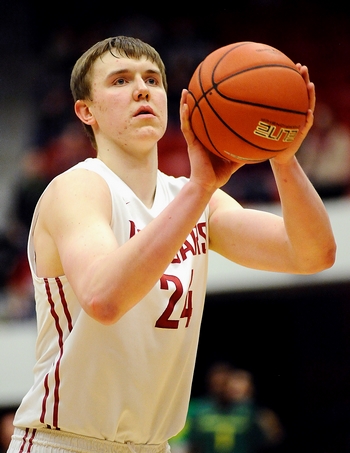
Unheralded as a high school recruit, Hawkinson's Division I interest was limited to just three schools (Washington State was the lone PAC-12 school to offer him a scholarship).
Upon arriving at Washington State, Hawkinson was a lanky big without much nuance to his game. Now, chiseled at 6-10 and 245 pounds, Hawkinson has bulked and toned his frame diligently over two years in Pullman at the behest of two different head coaches.
Washington State's former coach Ken Bone saw a 220-pound lanky incoming freshman and planned for Hawkinson to pack on pounds in the mold of a former WSU star Aron Baynes. But as Hawkinson's frame filled out to 270 pounds as a freshman, his conditioning lagged behind and he failed to see consistent time on the court playing in just 6.7 minutes per game for a bottom feeder in the conference.
Last year, however, with the coaching change from Bone to Ernie Kent, Hawkinson's opportunities were expanded in a starter's role. Kent envisioned Hawkinson as more of a stretch four than as a one-dimensional bruiser and, as he slimmed down to 245, his speed and explosiveness improved. After averaging just 1.1 points and 1.4 rebounds per game as a freshman, Hawkinson averaged 14.7 points and 10.8 rebounds as a sophomore, registering 20 double-doubles on the season (fourth most in the nation).
Moreover, our database shows he was the only PAC-12 player to finish in the top 15 in the conference in points, rebounds, free throw attempts and blocks.
Hawkinson's chances as an NBA prospect hinge on his continued emergence as a rebounder and defender, while capitalizing on his enticing potential as a floor spacer offensively.
A decidedly below the rim player, Hawkinson does not have great size for the center position he typically plays at just 6-10. Nevertheless, Hawkinson was one of the best defensive rebounders in college basketball last season, hauling in over 10 per-40 minutes, good for fourth in the NCAA. He uses his body extremely well to box out and is quick with anticipation off the glass, showing a cleverness to slyly maneuver opponents out of position before they realize it, to go along with a tremendous motor and a knack for pursuing loose balls off the glass.
While Kent has tried to utilize Hawkinson's smooth shooting mechanics to turn him into a dynamic floor spacer, Hawkinson has yet to find confidence with his shots from behind the foul line. He shot just 27-for-88 (30.6%) from 17 feet and beyond, including 6-for-30 (20%) on three point attempts. He has a quick release and shows glimpses of potential as a floor spacer when his confidence beams. Still, his footwork and hand positioning in the lead up to his shots is a little awkward.
Considering his average physical tools, continuing to improve the range on his jumper will be important for his pro prospects, as it will be difficult for him to make a living strictly around the basket against NBA competition. The fact that he converted an impressive 85% of his attempts from the free throw line shows the type of touch Hawkinson possesses, and certainly leaves room for optimism regarding his future development.
On the interior Hawkinson is one of the most polished players in college basketball. Hawkinson identifies mismatches early and seals positioning in the post like a veteran. Per Synergy, about 20% of Hawkinson's possessions came from the low-post where he shot 50% and got to the free throw line on a quarter of his possessions.
When he doesn't post, Hawkinson is equally adept at trying to maneuver around his defender with a spin or dribble en route to a high efficiency look at the rim. 36.5% of Hawkinson's offensive possessions came around the hoop in non-post up situations and he shot 66-for-107 (61.7%) on those opportunities. Essentially, when Washington State tossed the ball inside to Hawkinson, good things happened.
Hawkinson is not comfortable dribbling in traffic and, to his credit, he rarely puts the ball on the floor unless it's absolutely necessary. As a pick-and-roll screener, he generally pops away from the hoop. He shot just 8-for-27 (29.6%) on pick-and-pops whereas he was virtually automatic when finishing his rolls to the basket.
But if his rebounding and polished interior skills are helping put Hawkinson on NBA teams' radars, his defense is clearly holding him back.
He was the defensive anchor for one of the worst defensive teams in the country last year. According to KenPom, Washington State's Adjusted Defense ranked 313th in the country and Hawkinson is partially to blame.
Hawkinson lacks the physical tools to be a standout in this area, not possessing a great combination of size, length or explosiveness, which makes it difficult for him to emerge as much of a rim protector. Making the transition to power forward could prove difficult as he does not show great lateral quickness stepping outside of the paint.
Hawkinson plays with solid effort, but opposing big men were able to find a good amount of success posting him up last season. On the pick and roll, he often appeared a step slow hedging out to the perimeter. Improved conditioning and experience could help down the road, as Hawkinson was playing his first real minutes of high-level action last season on a team that was often overwhelmed from a talent standpoint. Finding a way to maximize his tools here would go a long way in improving his pro prospects.
Overall, Hawkinson's rebounding and soft shooting touch will certainly get him some looks from the NBA considering how productive he is in the competitive Pac-12. With Davonté Lacy, Washington State's leading scorer from last year graduated, the team will rely on Hawkinson to continue his ascent as a dominant offensive big man in the PAC-12. With another summer to work on his conditioning and improve his perimeter touch, it will be interesting to see what kind of jump he can make this upcoming season.
Josh Hawkinson, the PAC-12's reigning Most Improved Player, virtually came out of nowhere to average a double-double and lead the nation in defensive rebounds per game (8.7) for the Washington State Cougars last season.

Unheralded as a high school recruit, Hawkinson's Division I interest was limited to just three schools (Washington State was the lone PAC-12 school to offer him a scholarship).
Upon arriving at Washington State, Hawkinson was a lanky big without much nuance to his game. Now, chiseled at 6-10 and 245 pounds, Hawkinson has bulked and toned his frame diligently over two years in Pullman at the behest of two different head coaches.
Washington State's former coach Ken Bone saw a 220-pound lanky incoming freshman and planned for Hawkinson to pack on pounds in the mold of a former WSU star Aron Baynes. But as Hawkinson's frame filled out to 270 pounds as a freshman, his conditioning lagged behind and he failed to see consistent time on the court playing in just 6.7 minutes per game for a bottom feeder in the conference.
Last year, however, with the coaching change from Bone to Ernie Kent, Hawkinson's opportunities were expanded in a starter's role. Kent envisioned Hawkinson as more of a stretch four than as a one-dimensional bruiser and, as he slimmed down to 245, his speed and explosiveness improved. After averaging just 1.1 points and 1.4 rebounds per game as a freshman, Hawkinson averaged 14.7 points and 10.8 rebounds as a sophomore, registering 20 double-doubles on the season (fourth most in the nation).
Moreover, our database shows he was the only PAC-12 player to finish in the top 15 in the conference in points, rebounds, free throw attempts and blocks.
Hawkinson's chances as an NBA prospect hinge on his continued emergence as a rebounder and defender, while capitalizing on his enticing potential as a floor spacer offensively.
A decidedly below the rim player, Hawkinson does not have great size for the center position he typically plays at just 6-10. Nevertheless, Hawkinson was one of the best defensive rebounders in college basketball last season, hauling in over 10 per-40 minutes, good for fourth in the NCAA. He uses his body extremely well to box out and is quick with anticipation off the glass, showing a cleverness to slyly maneuver opponents out of position before they realize it, to go along with a tremendous motor and a knack for pursuing loose balls off the glass.
While Kent has tried to utilize Hawkinson's smooth shooting mechanics to turn him into a dynamic floor spacer, Hawkinson has yet to find confidence with his shots from behind the foul line. He shot just 27-for-88 (30.6%) from 17 feet and beyond, including 6-for-30 (20%) on three point attempts. He has a quick release and shows glimpses of potential as a floor spacer when his confidence beams. Still, his footwork and hand positioning in the lead up to his shots is a little awkward.
Considering his average physical tools, continuing to improve the range on his jumper will be important for his pro prospects, as it will be difficult for him to make a living strictly around the basket against NBA competition. The fact that he converted an impressive 85% of his attempts from the free throw line shows the type of touch Hawkinson possesses, and certainly leaves room for optimism regarding his future development.
On the interior Hawkinson is one of the most polished players in college basketball. Hawkinson identifies mismatches early and seals positioning in the post like a veteran. Per Synergy, about 20% of Hawkinson's possessions came from the low-post where he shot 50% and got to the free throw line on a quarter of his possessions.
When he doesn't post, Hawkinson is equally adept at trying to maneuver around his defender with a spin or dribble en route to a high efficiency look at the rim. 36.5% of Hawkinson's offensive possessions came around the hoop in non-post up situations and he shot 66-for-107 (61.7%) on those opportunities. Essentially, when Washington State tossed the ball inside to Hawkinson, good things happened.
Hawkinson is not comfortable dribbling in traffic and, to his credit, he rarely puts the ball on the floor unless it's absolutely necessary. As a pick-and-roll screener, he generally pops away from the hoop. He shot just 8-for-27 (29.6%) on pick-and-pops whereas he was virtually automatic when finishing his rolls to the basket.
But if his rebounding and polished interior skills are helping put Hawkinson on NBA teams' radars, his defense is clearly holding him back.
He was the defensive anchor for one of the worst defensive teams in the country last year. According to KenPom, Washington State's Adjusted Defense ranked 313th in the country and Hawkinson is partially to blame.
Hawkinson lacks the physical tools to be a standout in this area, not possessing a great combination of size, length or explosiveness, which makes it difficult for him to emerge as much of a rim protector. Making the transition to power forward could prove difficult as he does not show great lateral quickness stepping outside of the paint.
Hawkinson plays with solid effort, but opposing big men were able to find a good amount of success posting him up last season. On the pick and roll, he often appeared a step slow hedging out to the perimeter. Improved conditioning and experience could help down the road, as Hawkinson was playing his first real minutes of high-level action last season on a team that was often overwhelmed from a talent standpoint. Finding a way to maximize his tools here would go a long way in improving his pro prospects.
Overall, Hawkinson's rebounding and soft shooting touch will certainly get him some looks from the NBA considering how productive he is in the competitive Pac-12. With Davonté Lacy, Washington State's leading scorer from last year graduated, the team will rely on Hawkinson to continue his ascent as a dominant offensive big man in the PAC-12. With another summer to work on his conditioning and improve his perimeter touch, it will be interesting to see what kind of jump he can make this upcoming season.
#20, Jordan Bell, 6'9, Sophomore, Power Forward, Oregon
Matt Williams
A consensus top-75 recruit in high school, who was subsequently forced to redshirt his first year at Oregon due to not being cleared academically until December, Jordan Bell got thrown into the fire as a freshman, averaging 4.9 points, 6 rebounds, and 2.6 blocks over 24 minutes per game, emerging as a regular starter for Oregon mid-year.
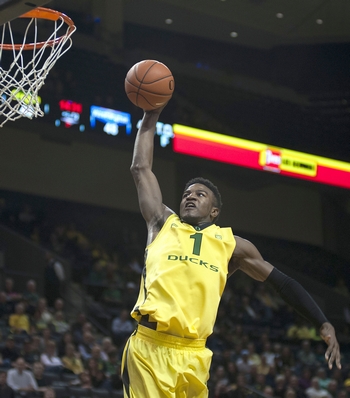
Listed at 6-9, with a long wingspan, Bell is a mobile, agile power forward who makes an impact with his athleticism. Tipping the scales around 220, Bell will need to get stronger in the coming seasons to help him hold his own inside, but he has plenty of time to work on his body in the coming years.
Skill-wise, Bell is a fairly limited player at this point, seeing most of his touches around the basket and in transition, while not being counted on for scoring regularly in Oregon's offense. Capable of playing above the rim and showing nice explosiveness inside, Bell has average footwork and touch and tries to do too much in the air at times. He finishes reliably, and flashes some potential as a midrange shooter and face up driver, but doesn't have a reliable means to create for himself at this stage. Getting to the line at a low rate, shooting only 50% once he gets there, and showing little post game to speak of, Bell has a long way to go offensively as his skill-level is clearly still catching up with his physical tools, even if he surprises you at times with his court vision and passing ability.
As a rebounder, Bell is capable on both ends, but could be more aggressive crashing the boards. He doesn't appear to have the best instincts, getting by largely on athleticism, and doesn't always seek out bodies to box out, two things he'll have to improve if he's to take the next step as a rebounder.
Where Bell does already make contributions is as a shot-blocker, an area where he ranked among the top-20 players in the entire country on a per-minute basis. An extremely aggressive off-ball defender, Bell pursues shots rotating over from the weakside with reckless abandon, swatting shots that many players wouldn't even pursue. Committing 4.4 fouls per-40 minutes pace adjusted while blocking 4.1 shots, Bell can be a bit too aggressive at times defensively, but flashes terrific potential as a rim protector.
As an on-ball defender, Bell is a bit less successful, as more mature, polished, and stronger post scorers take advantage of his lack of strength and discipline inside. He has nice foot speed allowing him to defend smaller players at times on the perimeter, but doesn't have a great grasp of how to use that to his advantage, often finding himself out of position when opposing players look to take him off the bounce. At this stage, Bell still has room to grow as a defender, but has a lot of upside on this end of the floor.
Unlike so many young, fairly raw defensive-oriented big men we've seen in the past, Jordan Bell got the opportunity to play significant minutes right away. While he wasn't overwhelmingly productive, his inclusion on the Pac-12 All-Defensive and All-Freshman teams a year ago is telling of how big his role was a year ago. Players in his mold can make big, sudden jumps in ability so it makes sense to continue to keep track of his progress to see how he's improving, and despite offseason foot surgery, there's little question Bell will have ample opportunity to showcase whatever progress he's made once again this season.
A consensus top-75 recruit in high school, who was subsequently forced to redshirt his first year at Oregon due to not being cleared academically until December, Jordan Bell got thrown into the fire as a freshman, averaging 4.9 points, 6 rebounds, and 2.6 blocks over 24 minutes per game, emerging as a regular starter for Oregon mid-year.

Listed at 6-9, with a long wingspan, Bell is a mobile, agile power forward who makes an impact with his athleticism. Tipping the scales around 220, Bell will need to get stronger in the coming seasons to help him hold his own inside, but he has plenty of time to work on his body in the coming years.
Skill-wise, Bell is a fairly limited player at this point, seeing most of his touches around the basket and in transition, while not being counted on for scoring regularly in Oregon's offense. Capable of playing above the rim and showing nice explosiveness inside, Bell has average footwork and touch and tries to do too much in the air at times. He finishes reliably, and flashes some potential as a midrange shooter and face up driver, but doesn't have a reliable means to create for himself at this stage. Getting to the line at a low rate, shooting only 50% once he gets there, and showing little post game to speak of, Bell has a long way to go offensively as his skill-level is clearly still catching up with his physical tools, even if he surprises you at times with his court vision and passing ability.
As a rebounder, Bell is capable on both ends, but could be more aggressive crashing the boards. He doesn't appear to have the best instincts, getting by largely on athleticism, and doesn't always seek out bodies to box out, two things he'll have to improve if he's to take the next step as a rebounder.
Where Bell does already make contributions is as a shot-blocker, an area where he ranked among the top-20 players in the entire country on a per-minute basis. An extremely aggressive off-ball defender, Bell pursues shots rotating over from the weakside with reckless abandon, swatting shots that many players wouldn't even pursue. Committing 4.4 fouls per-40 minutes pace adjusted while blocking 4.1 shots, Bell can be a bit too aggressive at times defensively, but flashes terrific potential as a rim protector.
As an on-ball defender, Bell is a bit less successful, as more mature, polished, and stronger post scorers take advantage of his lack of strength and discipline inside. He has nice foot speed allowing him to defend smaller players at times on the perimeter, but doesn't have a great grasp of how to use that to his advantage, often finding himself out of position when opposing players look to take him off the bounce. At this stage, Bell still has room to grow as a defender, but has a lot of upside on this end of the floor.
Unlike so many young, fairly raw defensive-oriented big men we've seen in the past, Jordan Bell got the opportunity to play significant minutes right away. While he wasn't overwhelmingly productive, his inclusion on the Pac-12 All-Defensive and All-Freshman teams a year ago is telling of how big his role was a year ago. Players in his mold can make big, sudden jumps in ability so it makes sense to continue to keep track of his progress to see how he's improving, and despite offseason foot surgery, there's little question Bell will have ample opportunity to showcase whatever progress he's made once again this season.

























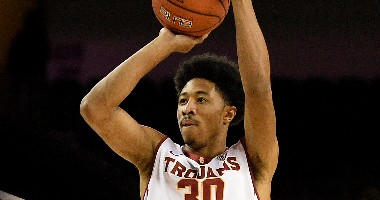

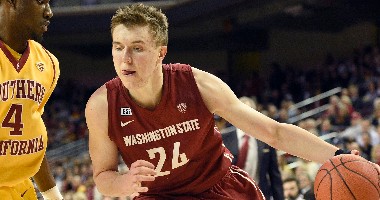

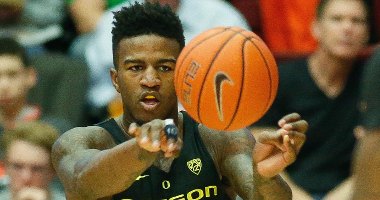





Comments